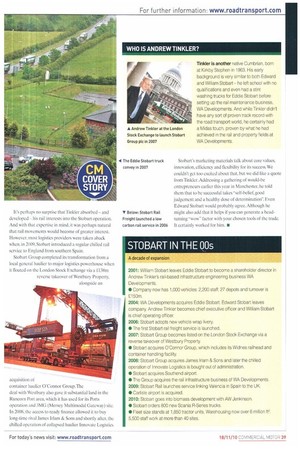200
Page 38

Page 39

If you've noticed an error in this article please click here to report it so we can fix it.
Living it up in the 21st century
In our final look at the history of the Stobart Group, CM charts the decade from the year 2000.1f you thought the firm's first 30 years were eventful, then you haven't seen anything yet
Words: Bob Tuck
At the turn of the new millennium, Eddie Stobart saw its turnover reach the £150m mark. The business was split into distinct parts, and while haulage made up around 66% of its workload, there was also warehousing: the company's international operation: the fan club, which included marketing arid merchandise: and also process management. This latter held involved Stobart staff working inside customer's premises to undertake management and/or loading services for a customer's traffic.
After 30 years of dramatic powth, it was perhaps not surprising that the group took time to catch its breath. Things were certainly stretched then: while turnover was impressive, there was little profitability. Over the years, Edward had decided that leasing trucks was a better option then buying them outright, and while he'd made a huge profit (on paper) through the sale and leaseback of a number of depots, the leasing aspect was proving a heavy drain on the firm's cash-flow. Indeed, its accounts for the 14 months ended 29 February 2004 showed a whopping £9.8m pre-tax loss.
But something was wrong at the top of the Stobart management tree, which culminated with William Stobart — Edward's younger brother and owner of 410% of the business — leaving in 2001 to take up a position with WA Developments, a Cumbrian rail infrastructure business owned by Andrew Tinkler.
Goodbye to Edward Stobart
However, within three years William was back at Stobart after it was acquired by WA Developments, but Edward Stobart then decided to leave, walking away from the business he had grown from a three-truck operation.
Six years later, not only has Andrew Tinkler almost doubled the Eddie Stobart fleet to 1,850 vehicles, he has also overseen the total diversification of Stobart Group. While the Eddie Stobart name is still seen on the general haulage fleet (albeit in a modernised livery), • it has moved the firm into several new areas, • with the Stobart Rail,Air and Ports divisions.
It's perhaps no surprise that Tinkler absorbed — and developed — his rail interests into the Stobart operation. And with that expertise in mind, it was perhaps natural that rail movements would become of greater interest. However. most logistics providers were taken aback when, in 2009. Stobart introduced a regular chilled rail service to England from southern Spain.
Stobart Group completed its transformation from a local general haulier to major logistics powerhouse when it floated on the London Stock Exchange via a £138m reverse takeover of \Westbury Property.
alongside an acquisition of container haulier O'Connor Group. The deal with Westbury also gave it substantial land in the Runcorn Port area, which it has used for its Ports operation and 3MG (Mersey Multimodal Gateway) site. In 2008, the access to ready finance allowed it to buy long-time rival James Irlarn & Sons and shortly after, the chilled operation of collapsed haulier Innovate Logistics. Stobart's marketing materials talk about core values, innovation, efficiency and flexibility for its success. We couldn't get too excited about that, but we did like a quote from Tinkler. Addressing a gathering of would-be entrepreneurs earlier this year in Manchester, he told them that to be successful takes "self-belief, good judgement and a healthy dose of determination". Even Edward Stobart would probably agree. Although he
• Below: Stobart Rail might also add that it helps if you can generate a head Freight launched a low turning "wow" factor with your chosen tools of the trade.
carbon rail. service in 2006 It certainly worked for him, •




































































































































